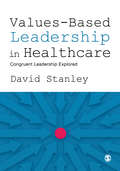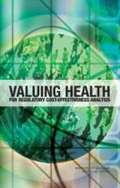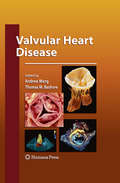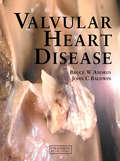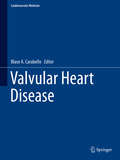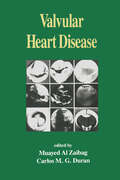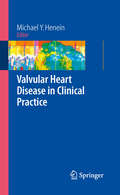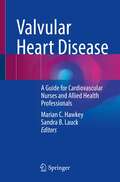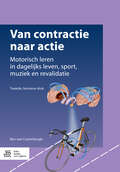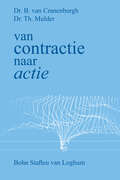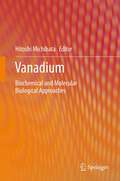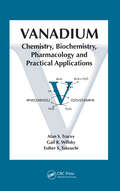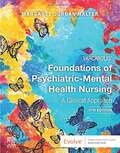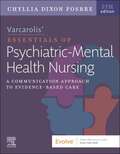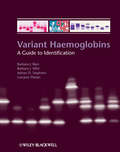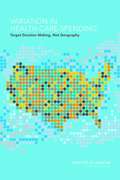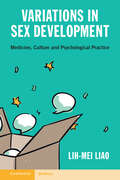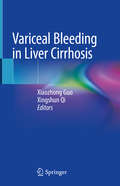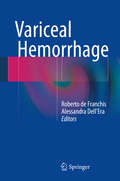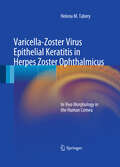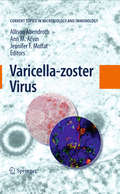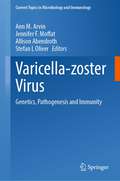- Table View
- List View
Values-Based Leadership in Healthcare: Congruent Leadership Explored
by David StanleyStanley's Values-Based Leadership in Healthcare proposes a bold new theory of leadership to help drive positive change in healthcare organisations. The theory of 'Congruent Leadership' is defined and presented through a series of corporate and clinical case studies and examples, which guide the reader through the possibilities for using their own values to inform best practice. Parallels are drawn between iconic historical figures and events, to show that healthcare professionals can be courageous leaders by following their values and learning from great leaders past and present. To aid understanding each chapter includes scenarios and reflective exercises to help readers grasp the application of theory to practice. By using an accessible frame of reference, Stanley outlines a refreshing alternative to existing theories of leadership and thoughtfully encourages practitioners to act in ethically-informed ways.
Valuing Animals: Veterinarians and Their Patients in Modern America (Animals, History, Culture)
by Susan D. JonesOver the course of the twentieth century, the relationship between Americans and their domestic animals has changed dramatically. In the 1890s, pets were a luxury, horses were the primary mode of transport, and nearly half of all Americans lived or worked on farms. Today, the pet industry is a multibillion-dollar-a-year business, keeping horses has become an expensive hobby, and consumers buy milk and meat in pristine supermarkets. Veterinarians have been very much a part of these changes in human-animal relationships. Indeed, the development of their profession—from horse doctor to medical scientist—provides an important perspective on these significant transformations in America's social, cultural, and economic history.In Valuing Animals, Susan D. Jones, trained as both veterinarian and historian, traces the rise of veterinary medicine and its impact on the often conflicting ways in which Americans have assessed the utility and worth of domesticated creatures. She first looks at how the eclipse of the horse by motorized vehicles in the early years of the century created a crisis for veterinary education, practice, and research. In response, veterinarians intensified their activities in making the livestock industry more sanitary and profitable. Beginning in the 1930s, veterinarians turned to the burgeoning number of house pets whose sentimental value to their owners translated into new market opportunities. Jones describes how vets overcame their initial doubts about the significance of this market and began devising new treatments and establishing appropriate standards of care, helping to create modern pet culture.Americans today value domestic animals for reasons that typically combine exploitation and companionship. Both controversial and compelling, Valuing Animals uncovers the extent to which veterinary medicine has shaped—and been shaped by—this contradictory attitude.
Valuing Health For Regulatory Cost-effectiveness Analysis
by Committee to Evaluate Measures of Health Benefits for Environmental Health Safety RegulationPromoting human health and safety by reducing exposures to risks and harms through regulatory interventions is among the most important responsibilities of the government. Such efforts encompass a wide array of activities in many different contexts: improving air and water quality; safeguarding the food supply; reducing the risk of injury on the job, in transportation, and from consumer products; and minimizing exposure to toxic chemicals. Estimating the magnitude of the expected health and longevity benefits and reductions in mortality, morbidity, and injury risks helps policy makers decide whether particular interventions merit the expected costs associated with achieving these benefits and inform their choices among alternative strategies. Valuing Health for Regulatory Cost-Effectiveness Analysis provides useful recommendations for how to measure health-related quality of- life impacts for diverse public health, safety, and environmental regulations. Public decision makers, regulatory analysts, scholars, and students in the field will find this an essential review text. It will become a standard reference for all government agencies and those consultants and contractors who support the work of regulatory programs.
Valvular Heart Disease
by Andrew Wang Thomas M. BashoreChallenges for the treatment of valvular heart disease include the growing need for effective yet less invasive interventions and therapies to treat these progressive conditions. With the development of potential new treatments, it is crucial for cardiac physicians to be well informed on the pathophysiology, assessment, treatment options and their outcomes of valvular diseases. Written by a highly experienced and internationally recognized group of cardiologists, cardiac surgeons, and researchers, Valvular Heart Disease offers insights into the widely varying hemodynamic effects and clinical course of heart valve conditions, as well as the contemporary management of these conditions. Offering a broad perspective on these diseases, Valvular Heart Disease expands on the recent guidelines developed by the major heart societies in the United State and Europe.
Valvular Heart Disease
by John Baldwin Bruce AndrusThe study of valvular heart disease has progressed rapidly over the past two decades. The understanding of etiology and natural history, the precision of noninvasive assessment, and the surgical and interventional management of valve disease have all improved dramatically. Coupled with an appreciation of physiologic principles, thoughtful interviews and physical exam, current technology allows clinicians to characterize all types of valve lesion. In addition, evolving techniques in interventional cardiology and cardiac surgery, guided by quantitative outcome analysis, have reduced the morbidity and mortality of these procedures.Reflecting all the above and evidence-based medical practice, the authors aim to provide a concise and straightforward guide to the recognition and management of valvular heart disease, complemented by current guidelines and abundant high-quality images. It will be a valuable reference for all involved in the care of patients with valvular heart disease, including cardiologists in practice and training, young hospital doctors, general physicians, cardiac nurse specialists, and medical students.
Valvular Heart Disease (Cardiovascular Medicine)
by Blase A. CarabelloThis book provides up-to-date and user-friendly guidance on the evaluation, diagnosis, and treatment of heart and vascular disease. Chapters cover a broad range of issues related to valve disease, including rheumatic fever, aortic root dilatation, infective endocarditis, and heart disease in pregnancy. The physical examination of major valve lesions, imaging techniques, and choosing a balance therapy are also discussed. Valvular Heart Disease aims to give readers exposure to guideline-directed therapy and therapeutic decisions and is relevant to trainee and practising cardiologists, cardiac surgeons, vascular surgeons, and cardiac radiologists.
Valvular Heart Disease (Fundamental and Clinical Cardiology)
by Muayed Al Zaibag Carlos M. G. DuranThis useful reference provides up-to-the-minute coverage of every aspect of valvular heart disease-presenting etiology, pathophysiology, and symptomatology in detail as well as current methods of diagnosis and treatment.Examines specific problems in valvular heart disease such as endocarditis, pregnancy, arrhythmias, rheumatic disease, acute regurgitation, and surgery in children and the elderly!Reviewing the latest invasive and non-invasive diagnostic techniques and analyzing the wide variety of management choices, Valvular Heart Disease explicates the pathology, echocardiography, and the radiological examination of valvular diseases discusses each of the heart valves elucidates possible pitfalls in diagnosis and management shows how to assess left and right ventricular function and how to time surgery illustrates the benefits and drawbacks of medical, interventional, and surgical management, including balloon catheter, valvotomy, and valve repair supplies an in-depth overview of conservative therapy and more!
Valvular Heart Disease in Clinical Practice
by Michael Y. HeneinThere is a need for all medical practitioners to be aware of the signs and symptoms of valve disease. The management of valvular disease is dominated by thorough investigations and optimum treatment. Valvular Heart Disease in Clinical Practice provides a toolkit for clinicians to guide them in the diagnosis and treatment of patients with suspected valvular heart disease. Algorithms and flow diagrams are included to give the reader an illustrated snapshot of the decisions involved in the management of these patients.
Valvular Heart Disease: A Guide for Cardiovascular Nurses and Allied Health Professionals
by Marian C. Hawkey Sandra B. LauckThis book serves as the “go-to” resource for cardiovascular nurses and other health care practitioners involved in the care of patients with acquired valvular heart disease. It includes unique information about heart valve anatomy and pathophysiology, the complexity of clinical presentations and diagnostic evaluation, patient education and shared decision-making, surgical and transcatheter treatment options, and transition to palliative care. The content focuses primarily on the specialized care of patients with aortic stenosis and regurgitation, and mitral and tricuspid regurgitation. In addition, this unique resource provides timely information to guide a patient-centred and team-driven approach that reflects contemporary and innovative practice in the management of valvular heart disease. The essential topics of strengthening the multidisciplinary Heart Team and programmatic processes of care, the priorities for nursing care, and the multifactorial challenges of managing this complex patient population are explored in detail. Importantly, this resource aims to support all clinicians who are involved in the various timepoints of patients’ full trajectory of care, from their evaluation pathway, admissions for treatment, and long term follow-up. Clinicians require contemporary knowledge and evidence to guide their practice, provide appropriate care for this complex patient population, and contribute to the advancement of practice. To date, there has been little emphasis placed on the management of valvular heart disease in cardiovascular nursing and allied health curriculum. This book fills this gap and addresses the pressing need for a user-friendly resource to guide the care for this growing population in a rapidly changing clinical environment. The editors are international leaders in the care and management of patients with acquired valvular heart disease and program development. They are widely recognized for their pioneering role in shaping the way we care for these patients.
Van contractie naar actie
by Ben Van CranenburghDit boek bespreekt de belangrijkste theorieën over het leren van motorische vaardigheden met het oog op de mogelijke toepassingen in sport, muziek en revalidatie. Het is bedoeld voor ieder die zich bezighoudt met het aanleren van motorische vaardigheden, professionals zoals sport-, muziek- en dansleraren , voor paramedici (fysiotherapeuten, ergotherapeuten en oefentherapeuten) maar zeker ook voor de ontwikkelde leek die als musicus, sporter of patiënt geïnteresseerd is in de mechanismen achter het leren van motorische vaardigheden.Mensen zijn tot indrukwekkende motorische prestaties in staat. De snelheid en nauwkeurigheid van een tennisservice, de vingervlugheid en fingerspitzengefühl van de musicus, de salto’s van de kunstschaatser en turner zijn verbazingwekkend. En dat geldt zelfs voor doodgewone dagelijks leven activiteiten zoals fietsen, timmeren of aardappels schillen. Sommige patiënten met hersenbeschadiging (bijv. beroerte) herstellen goed, andere niet, waarom? Goed om daar eens bij stil te staan.Motorisch leren is ondenkbaar zonder hersenen. Er niet één hersengebied voor motoriek, maar talrijke hersengebieden blijken betrokken. Dit strookt geheel met het huidige inzicht dat het leren van motorische vaardigheden onlosmakelijk verbonden is met sensoriek, emoties en cognitie.Er is zeker niet één superieure leermethode, maar er bestaat een uitgebreid palet aan mogelijke leerstrategieën waaruit weloverwogen gekozen kan worden op basis van iedere individuele situatie. Aan de hand van vele uitgewerkte praktische voorbeelden op het gebied van sport, muziek en revalidatie, laat het boek zien dat de wetenschappelijke inzichten over motorisch leren hun directe toepassing in de praktijk kunnen hebben.
Van contractie naar actie: Motorisch leren in dagelijks leven, sport, muziek en revalidatie
by Ben van CranenburghDit boek bespreekt de belangrijkste theorieën over het leren van motorische vaardigheden met het oog op de mogelijke toepassingen in sport, muziek en revalidatie. Het is bedoeld voor ieder die zich bezighoudt met het aanleren van motorische vaardigheden. Denk aan professionals zoals sport-, muziek- en dansleraren, of paramedici als fysiotherapeuten, ergotherapeuten en oefentherapeuten. Maar het is zeker ook waardevol voor de ontwikkelde leek die als musicus, sporter of patiënt geïnteresseerd is in de mechanismen achter het leren van motorische vaardigheden. Theorieën over motorisch leren en de rol die de hersenen daarbij spelen, zijn nadrukkelijk in beweging Van contractie naar actie. Motorisch leren in dagelijks leven, sport, muziek en revalidatie maakt deel uit van de zesdelige serie ‘Toegepaste neurowetenschappen’. Deze derde editie is geactualiseerd. Er zijn onder andere praktisch bruikbare ideeën toegevoegd over belangrijke aspecten zoals talent, ‘mindset’ en ‘mental effort’. Mensen zijn tot indrukwekkende motorische prestaties in staat. De snelheid en nauwkeurigheid van een tennisservice, de vingervlugheid en het Fingerspitzengefühl van de musicus, de salto’s van de kunstschaatser en turner zijn verbazingwekkend. En dat geldt zelfs voor doodgewone activiteiten uit het dagelijks leven zoals fietsen, timmeren of aardappels schillen. Sommige patiënten met hersenbeschadiging (bijv. een beroerte) herstellen goed, andere niet – de vraag is waarom? Goed om ook daar eens bij stil te staan. Motorisch leren is ondenkbaar zonder hersenen. De motoriek wordt niet aangestuurd vanuit één bepaald hersengebied, maar er blijken talrijke hersengebieden bij betrokken te zijn. Dit strookt geheel met het huidige inzicht dat het leren van motorische vaardigheden onlosmakelijk verbonden is met sensoriek, emoties en cognitie. Er is zeker niet één superieure leermethode, maar er bestaat een uitgebreid palet aan mogelijke leerstrategieën waaruit weloverwogen gekozen kan worden op basis van iedere individuele situatie. Aan de hand van vele uitgewerkte praktische voorbeelden op het gebied van sport, muziek en revalidatie laat het boek zien dat de wetenschappelijke inzichten over motorisch leren hun directe toepassing in de praktijk kunnen hebben. Ben van Cranenburgh studeerde geneeskunde in Amsterdam en was als wetenschappelijk medewerker verbonden aan onder meer het Nederlands Centraal Instituut voor Hersenonderzoek en het Revalidatie Centrum Amsterdam. In 1987 richtte hij het Instituut voor toegepaste neurowetenschappen (stichting ITON) op, waar hij tot op heden werkzaam is. De stichting ITON biedt nascholingscursussen aan op het gebied van de toegepaste Neurowetenschappen.
Van contractie naar actie: Theorieen over motoriek en toepassingen in sport, therapie en pedagogiek
by B. van CranenburghIedere student breekt zich wel eens het hoofd over het juiste gebruik van de medische terminologie. Gelukkig is er nu het "Groene Boekje" voor medische termen! In dit boekje: de logica van de medische taal door deze te ontleden tot stamwoorden en voor- en achtervoegsels, een opsomming van regels die gelden voor de uitspraak van medische termen en het gebruik van enkel- en meervoud. Ook worden andere relevante (taalkundige) aspecten beschreven. Aan de orde komen o.a. het gelegitimeerd gebruik van Nederlandse termen, het liggend streepje, afkortingen, de belangrijkste verschillen tussen oude en nieuwe spelling, medische eponiemen, eenheden en hun voorvoegsels. Achterin is een alfabetische lijst opgenomen met een groot aantal medische termen.
Vanadium
by Hitoshi MichibataThe publication of Vanadium: Biochemical and Molecular Biological Approaches is particularly timely as it exactly coincides with the centennial anniversary of the discovery of vanadium by Professor Henze, in the blood cells of an ascidian (tunicate) collected in Gulf of Naples in 1911. Vanadium, atomic number 23, covers a wide range of oxidation states (from -2 to +5) and has unpaired electrons. Depending on these properties, a wide variety of enzymes and compounds containing vanadium have been found and the biochemical behaviour of vanadium has been investigated extensively. This monograph provides not only the basic properties and recent advances of vanadium chemistry but also presents recent topics on hyper-accumulators of vanadium, enzymatic roles of vanadium, biochemical functions of vanadium and medicinal functions of vanadium, which have been discovered by Biochemical and Molecular Biological Approaches. Vanadium: Biochemical and Molecular Biological Approaches is aimed at pure and applied chemists, biochemists, pharmaceutical and medical scientists.
Vanadium: Chemistry, Biochemistry, Pharmacology and Practical Applications
by Alan S. Tracey Gail R. Willsky Esther S. TakeuchiThe first comprehensive resource on the chemistry of vanadium, Vanadium: Chemistry, Biochemistry, Pharmacology, and Practical Applications has evolved from over a quarter century of research that concentrated on delineating the aqueous coordination reactions that characterize the vanadium(V) oxidation state. The authors distill information o
Vanished in Hiawatha: The Story of the Canton Asylum for Insane Indians
by Carla JoinsonBegun as a pork-barrel project by the federal government in the early 1900s, the Canton Asylum for Insane Indians quickly became a dumping ground for inconvenient Indians. The federal institution in Canton, South Dakota, deprived many Native patients of their freedom without genuine cause, often requiring only the signature of a reservation agent. Only nine Native patients in the asylum’s history were committed by court order. Without interpreters, mental evaluations, or therapeutic programs, few patients recovered. But who cared about Indians and what went on in South Dakota? After three decades of complacency, both the superintendent and the city of Canton were surprised to discover that someone did care and that a bitter fight to shut the asylum down was about to begin. In this disturbing tale, Carla Joinson unravels the question of why this institution persisted for so many years. She also investigates the people who allowed Canton Asylum’s mismanagement to reach such staggering proportions and asks why its administrators and staff were so indifferent to the misery experienced by patients.Vanished in Hiawatha is the harrowing tale of the mistreatment of Native American patients at a notorious insane asylum whose history helps us to understand the broader mistreatment of Native peoples under forced federal assimilation in the nineteenth and early twentieth centuries.
Varcarolis' Foundations of Psychiatric-Mental Health Nursing: A Clinical Approach
by Margaret Jordan HalterPrepare for psychiatric nursing care with this comprehensive, evidence-based text! Varcarolis' Foundations of Psychiatric-Mental Health Nursing: A Clinical Approach, 9th Edition makes it easy to understand the complexities of psychiatric disorders and how to provide quality mental and behavioral health care. Clinical chapters follow the nursing process framework and progress from theory to application, preparing you for practice with real-world examples. Other notable features include illustrated explanations of the neurobiology of disorders, DSM-5 criteria for major disorders, and nursing care plans. From clinical nurse specialist and lead author Dr. Margaret Jordan Halter, this bestselling text includes new Next Generation NCLEX® content to prepare you for success on your PMHN certification exam.
Varcarolis’ Essentials of Psychiatric Mental Health Nursing: A Communication Approach to Evidence-Based Care
by Chyllia D Fosbre MSN RN PMHNP-BCVarcarolis’ Essentials of Psychiatric-Mental Health Nursing: A Communication Approach to Evidence Based Care, 5th Edition provides a concise, easy-to-understand guide to today’s leading psychiatric theories and therapeutic modalities. Emphasizing evidence-based care, the book balances coverage of scientifically based treatment approaches with insights into effective communication skills, so you will be prepared to offer the best possible care when you enter practice. Written by nursing expert Chyllia D. Fosbre, this edition adds new Next Generation NCLEX® (NGN) examination-style case studies to help you develop critical thinking skills and prepare for the NGN exam.
Variant Haemoglobins: A Guide to Identification
by Barbara J. Bain Adrian Stephens Lorraine Phelan Barbara WildVariant Haemoglobins – A Guide to Identification is based on the premise that any single diagnostic technique offers only a very provisional identification of a variant haemoglobin. In routine diagnostic practice two techniques are needed as a minimum, with the results being interpreted in the light of the clinical details, blood count, blood film and ethnic origin. This book covers 150 normal and variant haemoglobins that have been studied and carefully documented. Variant Haemoglobins has four introductory chapters followed by an invaluable atlas. The introductory chapters cover the genetics of haemoglobin synthesis the principles of tests employed for identification common haemoglobins of major clinical or diagnostic importance thalassaemias and related conditions The atlas section comprises 170 full colour pages in which each variant haemoglobin or combination of haemoglobins is illustrated by cellulose acetate electrophoresis at alkaline pH, agarose gel electrophoresis at acid pH, isoelectric focusing and one or more HPLC traces. For ease of reference, the atlas pages are arranged according to the retention time of each haemoglobin on HPLC, this becoming increasingly the primary technique employed in haemoglobin identification. Bringing a mix of necessary scientific expertise and clinical knowledge, each author has more than 30 years experience in the diagnosis of variant haemoglobins. Providing otherwise unavailable information, this unique and practical guide is illustrated with over 700 high quality colour digital images plus flow charts and line diagrams covers common and important haemoglobin variants, in addition to many rarer ones is an essential reference source for diagnosis in the haematology laboratory A remarkably useful book, Variant Haemoglobins will be valuable for haematopathologists, clinical and laboratory haematologists in practice and in training and all laboratory staff involved in haemoglobinopathy diagnosis.
Variation in Health Care Spending
by Joseph P. NewhouseHealth care in the United States is more expensive than in other developed countries, costing $2. 7 trillion in 2011, or 17. 9 percent of the national gross domestic product. Increasing costs strain budgets at all levels of government and threaten the solvency of Medicare, the nation's largest health insurer. At the same time, despite advances in biomedical science, medicine, and public health, health care quality remains inconsistent. In fact, underuse, misuse, and overuse of various services often put patients in danger. Many efforts to improve this situation are focused on Medicare, which mainly pays practitioners on a fee-for-service basis and hospitals on a diagnoses-related group basis, which is a fee for a group of services related to a particular diagnosis. Research has long shown that Medicare spending varies greatly in different regions of the country even when expenditures are adjusted for variation in the costs of doing business, meaning that certain regions have much higher volume and/or intensity of services than others. Further, regions that deliver more services do not appear to achieve better health outcomes than those that deliver less. Variation in Health Care Spending investigates geographic variation in health care spending and quality for Medicare beneficiaries as well as other populations, and analyzes Medicare payment policies that could encourage high-value care. This report concludes that regional differences in Medicare and commercial health care spending and use are real and persist over time. Furthermore, there is much variation within geographic areas, no matter how broadly or narrowly these areas are defined. The report recommends against adoption of a geographically based value index for Medicare payments, because the majority of health care decisions are made at the provider or health care organization level, not by geographic units. Rather, to promote high value services from all providers, Medicare and Medicaid Services should continue to test payment reforms that offer incentives to providers to share clinical data, coordinate patient care, and assume some financial risk for the care of their patients. Medicare covers more than 47 million Americans, including 39 million people age 65 and older and 8 million people with disabilities. Medicare payment reform has the potential to improve health, promote efficiency in the U. S. health care system, and reorient competition in the health care market around the value of services rather than the volume of services provided. The recommendations of Variation in Health Care Spending are designed to help Medicare and Medicaid Services encourage providers to efficiently manage the full range of care for their patients, thereby increasing the value of health care in the United States.
Variations in Sex Development: Medicine, Culture and Psychological Practice
by Lih-Mei LiaoBiological variations in sex development, also known as intersex, are greatly misunderstood by the wider public. This unique book discusses psychological practice in healthcare for people and families impacted by a range of 'intersex' variations. It highlights the dilemmas facing individuals and their loved ones in the social context and discusses the physical and psychological complexities of irrevocable medical interventions to approximate social norms for bodily appearance and function. It exposes the contradictions in medical management and suggests valuable theoretical and practice tools for psychosocial care providers to navigate them. Uniquely featuring theory and research informed practice vignettes, the book explores interpersonal work on the most salient psychosocial themes, ranging from grief work with impacted caretakers to sex therapy with impacted adults. An indispensable resource for working ethically, pragmatically and creatively for a variety of healthcare specialists and those affected by variations in sex development and their families and communities.
Variceal Bleeding in Liver Cirrhosis
by Xingshun Qi Xiaozhong GuoThis book discusses the management of variceal bleeding in liver cirrhosis, covering a wide range of topics, including epidemiology, mechanism, diagnosis and monitoring, prophylaxis, treatment, and prognostic assessment. It also presents the latest research in the field, such as non-invasive approaches, self-expanding metal stents, hemostatic powder, and early TIPS. The book is a valuable resource for physicians wanting to establish standard treatment strategies, researchers launching innovative clinical and experimental studies, and also for patients and their relatives wishing to gain a better understanding of this disease.
Variceal Hemorrhage
by Roberto Franchis Alessandra Dell'EraVariceal Hemorrhage provides an update of the evidence concerning several aspects of variceal hemorrhage. The book features new information on natural history, diagnosis of esophageal varices, assessment of the risk of bleeding and identification of high risk groups and patients who may benefit or be harmed from different treatments. The volume also presents a critical analysis of the different steps in the management of acute variceal bleeding. Authored by the most prominent world experts in their areas of expertise, Variceal Hemorrhage serves as a very useful reference for gastroenterologists, GI surgeons, residents in internal medicine and physicians dealing with and interested in the different aspects of this severe medical emergency.
Varicella-Zoster Virus Epithelial Keratitis in Herpes Zoster Ophthalmicus: In Vivo Morphology in the Human Cornea
by Helena M. TaberyHerpes zoster ophthalmicus (HZO) is a common disease in the elderly and the immunosuppressed, with potentially devastating sequelae. Diagnosis of HZO is clinical but almost all its manifestations are non-specific. The exception is varicella-zoster virus epithelial keratitis, which is frequently the only indicator of the true nature of the disease. This book is unique in presenting high-magnification images, obtained by non-contact in vivo photomicrography, that capture the distinctive features of varicella-zoster virus epithelial keratitis in HZO. Both the morphology and the dynamics of the corneal epithelial lesions are splendidly documented, including in patients with HZO sine herpete and recurrent disease. Three rare cases of ocular surface involvement in acute HZO are included, and the final chapter carefully compares varicella-zoster virus epithelial keratitis in HZO and the lesions of herpes simplex virus.
Varicella-zoster Virus
by Ann M. Arvin Jennifer F. Moffat Allison AbendrothVaricella-zoster virus is a common human pathogen that causes varicella (chickenpox), establishes latency in sensory nerve ganglia and can reactivate many years later as herpes zoster. VZV is the only human herpesvirus for which vaccines to prevent both primary and recurrent infection are approved and VZV vaccines have had significant public health benefits. These achievements and new directions that are unfolding are described in this review of VZV basic and clinical research
Varicella-zoster Virus: Genetics, Pathogenesis and Immunity (Current Topics in Microbiology and Immunology #438)
by Ann M. Arvin Jennifer F. Moffat Allison Abendroth Stefan L OliverThis edited volume provides insights about the molecular virology, pathoenesis of infection and host responses to varicella-zoster virus, which is a medically important human herpesvirus. The chapters not only discuss genetics and molecular evolution of the virus, but also new structure-based knowledge on the functions of viral glycoproteins. Further, the authors illustrate how mechanisms from the virus are used to take over and remodel host cells during pathogeneis. These mechanisms also enable viral modulation of host cells and evasion of the host immune response. Part of these evasion and survival strategies, is the reaction to triggered host cell responses like autophagy, the stress response, modulation of apoptosis and other cell death pathways. This hands-on knowledge is crucial for students and clinicians in Virology, Immunology, and Infectious Diseases.Chapter "Common features between stroke following varicella in children and stroke following herpes zoster in adults" is available open access under a Creative Commons Attribution 4.0 International License via Springerlink.com.
